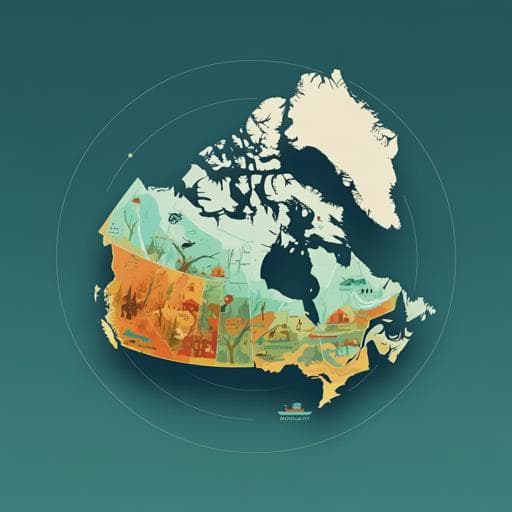
Economics
Financial stability in response to climate change in a northern temperate economy
K. Stan, G. A. Watt, et al.
This groundbreaking research conducted by Kayla Stan, Graham A. Watt, and Arturo Sanchez-Azofeifa uncovers the economic impacts of climate change in Canada, revealing surprising insights about GDP changes and regional vulnerabilities. It challenges conventional models by exploring a wider array of climate variables, paving the way for better adaptation strategies worldwide.
~3 min • Beginner • English
Introduction
The study examines how climate change influences economic output and financial stability, emphasizing that past work has largely focused on average temperature and annual horizons, overlooking other climate variables and sub-annual economic dynamics. The authors propose an empirically based, flexible non-linear method to estimate changes in GDP and sub-annual economic cycle characteristics (period, amplitude, trough depth) attributable to climate variability. Canada is used as a case study due to its large, diverse, northern temperate climate with amplified warming and varied regional economies. The research aims to improve understanding of climate–economy relationships and inform targeted adaptation and resilience policies at sub-national levels.
Literature Review
Prior literature on climate-economy impacts has typically relied on average temperature as the primary explanatory variable, often using probabilistic models and annual data. These approaches have been criticized for insufficiently capturing cold-weather variables (e.g., snow, heating degree days) and for underrepresenting financial stability considerations. Studies often predict GDP declines or minimal increases under climate change, and rarely address sub-annual economic cycles that relate to infrastructure stress and credit risk. There is also a call to study aggregated economic output, not only damages, and to improve temporal resolution to capture dynamics like recession timing and trough depths.
Methodology
Data: Historical provincial climate variables (monthly mean, max, min temperature; precipitation; snow; heating and cooling degree days) from Government of Canada archives; future climate from Climate Atlas of Canada and Climate Data Canada (PCIC downscaled models), primarily RCP 8.5. Snowfall from CANESM2. Historical climate data span 2000–2019; projections 2025–2095. Economic data include national GDP by industry (monthly), annual national and provincial GDP Supply and Use tables, monthly provincial wholesale trade (proxy for sub-provincial economic activity), and interprovincial/international trade flows from Statistics Canada.
Data processing: Economic data were detrended using average annual growth to isolate climate effects. To reduce pseudoreplication, data were pooled/binned by temperature (1, 2, 3, 5°C bins) and precipitation (5 mm bins), averaging months within bins (e.g., Alberta months with 1–2°C). Climate data were cleaned for QC flags; normality was tested with Shapiro–Wilk (all normal).
Model testing: Linear models (GLM, GLMM, LARS) and non-linear models (Decision Trees, Random Forests with 1000 trees, MARS) were evaluated. LARS was the only linear model with significant relationships but explained at most R^2≈0.5. Random Forest performance varied by province and was generally below R^2≈0.7. MARS (Multivariate Adaptive Regression Splines) outperformed others, allowing non-linear relationships and interactions; performance assessed via R^2 and GR^2 (cross-validation metric).
Model optimization: For each province, optimal binning, variable sets, and inclusion of month/season indicators were selected based on significance, R^2, and GR^2. Variable importance assessed by inclusion/exclusion and stepwise procedures. Many provinces performed best with 1–2°C binning; some benefited from including month as a predictor. Six provinces achieved R^2>0.8, two R^2>0.7, and two (Alberta, Nova Scotia) R^2>0.5.
Projections and uncertainty: Using optimized provincial MARS models, monthly economic values were projected 2025–2095 under RCP 8.5 using ensemble and 24–27 climate models, with mean, 10th, and 90th percentiles. Uncertainty assessed via (1) binning sensitivity (using mean/min/max economic values from bins) and (2) multi-model climate ensembles. Trends evaluated with Mann–Kendall and seasonal Mann–Kendall tests.
Economic cycling: Monthly projections were smoothed with a Savitzky–Golay filter in TIMESAT to extract cycle metrics: start/end, length (period), peak, trough, amplitude. Trends in cycle period, amplitude, and trough depth were analyzed; trough trends served as a proxy for credit risk. A quadrant framework categorized infrastructure stress by combined changes in period and amplitude (e.g., increased amplitude with decreased period indicates higher volatility and stress).
Trade–GDP linkage: Strong correlation between log-transformed trade and GDP (p<0.001; R^2>0.9) supports using trade as a sub-annual proxy. Interprovincial trade interdependencies were mapped; the share of imports from high-stress provinces was used to estimate trade at risk.
Key Findings
- Model performance: Mean temperature alone explained up to ~40% of GDP variability. Adding precipitation and snow raised explained variance by ~10% (R^2≈0.53; GR^2≈0.38). Including heating and cooling degree days further improved performance by ~19% (R^2≈0.72; GR^2≈0.50). Temperature-only projections under-predicted 2095 annual GDP by about $400 billion CAD (~20%) relative to the optimized MARS model.
- National GDP impacts (RCP 8.5, 2025–2095): The model projects an average annual GDP change of +0.03% above the historical 2.6% growth rate attributable to climate factors; cumulatively, annual GDP levels are ~2.5% higher than current values due solely to climatic change by 2095. A temperature-only model projected −0.04% per year (−2% by 2095). The cumulative difference between optimized and temperature-only models over the horizon is ~5%, or ~$7.4 trillion CAD.
- Regional/provincial GDP projections: Prairie region shows the largest variability and changes. By 2095, projected changes: Alberta +3.2%, Saskatchewan −12.6%, Manitoba +11.4%. Southeastern region increases significantly: Ontario +1.1%, Quebec +3.9%. Atlantic Maritime provinces show mixed significant increases/decreases. Pacific Maritime (British Columbia) shows no significant productivity change and milder projected climate changes.
- Variable importance: At regional and seasonal levels, cold-weather variables (snow, heating degree days, minimum temperature) frequently dominated explanatory power; mean temperature and precipitation were significant but often not apex variables.
- Economic cycle stress: Provinces with highest stress (increased amplitude and/or decreased period, implying greater volatility and deeper troughs/credit risk) include Alberta, Saskatchewan, Prince Edward Island, and New Brunswick. Ontario and Quebec fall into a lower-stress quadrant with slight decreases in amplitude and period, implying stabilization and reduced credit risk.
- Interdependencies and trade at risk: Stabilization in Southeastern Canada (Ontario, Quebec) may enhance national financial stability due to their large interprovincial trade links. Shares of imports from high-stress provinces (trade at risk) include: Saskatchewan 48% (highest), Manitoba 42%, Ontario 38%, Nova Scotia 38%, Newfoundland 30%, Prince Edward Island 30%, British Columbia 22%, Quebec 20%, New Brunswick 18%, Alberta 11%. Stressed provinces, especially Alberta, contribute a large share of exports, suggesting priority for resilience and adaptive management policies there.
Discussion
Including a comprehensive set of climate variables materially changes economic projections relative to temperature-only models. Accounting for cold-weather variables improves model accuracy and shifts national projections from GDP decreases to modest increases under RCP 8.5. Sub-annual analysis reveals important changes in cycle period, amplitude, and trough depth that are relevant to credit risk and infrastructure planning—insights not captured by annual models. Regional differences likely reflect industrial composition: resource dependence in the Prairies versus diversified manufacturing, shipping, and technology in the Southeast; fishing and mining in the Atlantic; finance and real estate in the Pacific. Increased cycle amplitude and shortened periods raise infrastructure stress and credit risk, particularly in Alberta, Saskatchewan, New Brunswick, and PEI, while Ontario and Quebec show stabilization that can support national resilience. Infrastructure capacity, timing of investment, and supply-chain constraints will mediate the ability to capture potential climate-related gains. Targeted, region-specific resilience investments are needed to mitigate risks and harness opportunities, with particular emphasis on highly stressed provinces.
The study underscores that ignoring non-temperature climate variables and sub-annual dynamics can mischaracterize climate–economy relationships. It also highlights the role of interprovincial trade networks in propagating or buffering climate-induced economic stresses.
Conclusion
The paper introduces an empirically robust, non-linear framework that integrates multiple climate variables and sub-annual economic dynamics to project climate-induced changes in GDP and economic cycles. Applied to Canada, the approach improves explanatory power by over 20% compared to temperature-only models and reverses the sign of national GDP impacts under RCP 8.5, while revealing substantial regional heterogeneity in both total output and cycle stress. Ontario and Quebec are projected to stabilize with reduced credit risk and increased trade, whereas the Prairie provinces—especially Alberta and Saskatchewan—and parts of the Atlantic Maritime face higher stress and credit risk. The framework enables assessment of infrastructure stress via changes in cycle period, amplitude, and trough depth, informing adaptation and resilience strategies. Future research should extend the analysis to other emissions scenarios, incorporate acute climate shocks and broader geopolitical risks, deepen industry-level modelling, and expand treatment of trade and investment network interdependencies. The method is transferable to other northern temperate economies to guide targeted resilience and policy design.
Limitations
Projections are based solely on historical climate–economy relationships and assume other determinants remain constant; they do not explicitly model future changes in policy, technology, demographics, or global economic structure. Acute climate-related events (wildfire, floods, sea-level rise, extreme heat) and compounding systemic risks (conflict, political instability, mass migration, biodiversity loss, food/water shortages) are not explicitly included, potentially leading to overestimation of growth given non-linear damage from extremes. The study primarily uses the high-emissions RCP 8.5 scenario (with ~35% likelihood to 2100), which may represent an upper bound on risks; alternative scenarios (e.g., RCP 4.5) could yield more conservative estimates. Uncertainty remains from binning procedures, model selection, and climate model spread, though these are partially quantified. Trade risk analysis is simplified and does not fully model network dynamics or sectoral heterogeneity.
Related Publications
Explore these studies to deepen your understanding of the subject.







